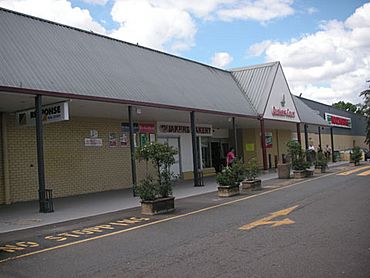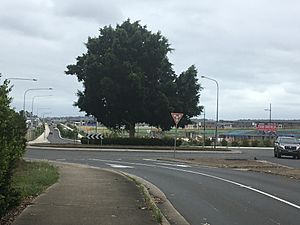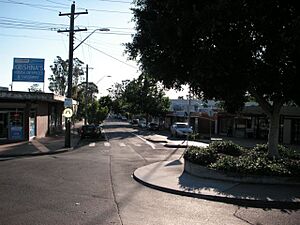Quakers Hill, New South Wales facts for kids
Quick facts for kids Quakers HillSydney, New South Wales |
|||||||||||||||
|---|---|---|---|---|---|---|---|---|---|---|---|---|---|---|---|

Quakers Court shopping centre c. 2009
|
|||||||||||||||
| Population | 27,080 (2016 census) | ||||||||||||||
| • Density | 2,927.6/km2 (7,582/sq mi) | ||||||||||||||
| Established | 1904 | ||||||||||||||
| Postcode(s) | 2763 | ||||||||||||||
| Elevation | 33 m (108 ft) | ||||||||||||||
| Area | 9.25 km2 (3.6 sq mi) | ||||||||||||||
| Location | 40 km (25 mi) north-west of Sydney CBD | ||||||||||||||
| LGA(s) | City of Blacktown | ||||||||||||||
| State electorate(s) | Blacktown Riverstone |
||||||||||||||
| Federal Division(s) | |||||||||||||||
|
|||||||||||||||
Quakers Hill is a suburb located in Sydney, New South Wales, Australia. It is about 40 kilometres (25 miles) north-west of the Sydney central business district. This area is part of the City of Blacktown local government area and is often called 'Quakers' by locals. It's a key part of the Greater Western Sydney region.
Contents
Exploring the History of Quakers Hill
The name 'Quaker' first appeared in New South Wales on maps as "Quaker's Row" in November 1788. This was a street in the early settlement of Rose Hill, which later became Parramatta. In July 1790, Governor Phillip planned a town with a wide road called Quakers Row.
Later, the people living in Quakers Row moved further west. They settled in an area that became known as The Quaker's Hills. Some stories say they were responsible for burying people who died during the 1804 uprising.
The name Quakers Hill was officially recorded in 1806 by government surveyor James Meehan. However, its exact origin is still a bit of a mystery. Over sixty years later, Thomas Harvey used the name for his property in the western part of what is now Quakers Hill.
When a railway station was built in 1872, it was first called Douglas' Siding. But in 1904, Harvey's Quakers Hill property was divided into smaller blocks. The new residents preferred the name Quakers Hill. So, in 1905, the railway station's name was changed to Quakers Hill.
Growth and Development Over Time
Quakers Hill started to grow steadily. Postal services began in 1907, and the first post office was built in 1915. A school opened in a church hall in 1911. Then, Quakers Hill Public School welcomed its first students in 1912.
The population increased a lot during the 1920s. More shops opened near the station, and a public hall called the Empire Theatre opened in 1925. This theatre showed movies and hosted dances, making the village a lively centre for nearby farms.
In the 1960s, Sydney's urban areas expanded, reaching Quakers Hill. The large five-acre farms around the village began to be divided into smaller housing blocks. In 1994, HMAS Nirimba, a naval training base, was closed. It was then turned into a place for education.
In 1996, a new housing area in north-east Quakers Hill became a separate suburb called Acacia Gardens. More recently, in November 2020, a small part of Quakers Hill north of the Parkway became part of the new suburb of Nirimba Fields.
A Community Event in 2011
On 18 November 2011, a serious incident occurred at a nursing home in Quakers Hill. This event led to a large emergency response and affected many residents. The community came together to support those impacted by the incident.
Getting Around Quakers Hill
Quakers Hill has good public transport options. You can travel by train from Quakers Hill railway station, which is on the Richmond line. There are also many bus services provided by Busways. These buses connect to the Sydney Metro network at stations like Tallawong, Rouse Hill, and Bella Vista.
Roads in Quakers Hill have also seen many improvements. A new road now leads directly to the education area, helping to ease traffic in the town centre. The Westlink M7 opened in December 2005. This major motorway connects Quakers Hill to other important routes across Sydney. The overpass for the Quakers Hill Parkway has also been made wider. It now has four lanes, improving traffic flow over the railway line.
Homes in Quakers Hill
Quakers Hill has a mix of different types of homes. You can find older houses, including some public housing, mainly in the southern parts of the suburb near Marayong. On the western side of the railway line, most houses are on standard blocks. Some of these were built when HMAS Nirimba was an active naval base, and others were built in the 1960s and 1970s.
The eastern side of the railway line has newer homes, mostly built since the 1980s. This area has a higher number of townhouses or homes built closer together.
Learning and Education in Quakers Hill
Quakers Hill is home to many schools and learning places. The oldest school is Quakers Hill Public School, which opened in 1912. To help with the growing number of students, two other public primary schools, Barnier and Hambledon, opened in the 1990s.
For high school students, there are two main options. Quakers Hill High School teaches students from Years 7 to 12. Wyndham College is for older students in Years 11 and 12. There is also a Catholic primary school called Mary Immaculate and a Catholic high school, Terra Sancta College.
For education after high school, students can go to Nirimba TAFE College or the University of Western Sydney, Blacktown Campus. Four of these places – the University of Western Sydney, Nirimba TAFE, Wyndham College, and St John Paul II College – are all located together in the Nirimba Education Precinct. This makes it a great hub for learning!
Understanding the Population of Quakers Hill
Quakers Hill has grown a lot in recent years and is now a well-populated suburb. In 1991, about 14,630 people lived here. By 1996, this number had increased to 18,759. The population continued to grow, reaching 25,015 in 2006. The 2016 ABS Census recorded a further increase, with 27,080 people living in Quakers Hill.
According to the 2016 Census, most people in Quakers Hill (58.0%) were born in Australia. The next largest group (10.4%) was born in India. When asked about their family background, most people identified as having Australian ancestry (19%), followed by English (18%).
In terms of religion, the 2016 Census showed that most people in Quakers Hill identified as Catholic (30.3%). The second most common response was 'No Religion' (15.5%).
Famous People from Quakers Hill
Quakers Hill has been home to several well-known individuals:
- Mel McLaughlin – An Australian sports journalist.
- Fabrice Lapierre – An Australian long jumper.
- Miracle – An Australian hip hop artist.
- Aaron Mooy – An Australian footballer who plays for the Socceroos and Celtic.
- Michael Clifford – An Australian guitarist from the band 5 Seconds of Summer.



